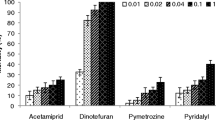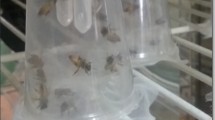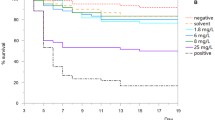Abstract
In this study, honey bees (Apis mellifera L.) were exposed to LD05 and LD50 doses of five commonly used acaricides for controlling the parasitic mite, Varroa destructor. LD50 values at 48 h post-treatment showed that tau-fluvalinate was the most toxic, followed by amitraz, coumaphos, thymol, and formic acid. However, the hazard ratios, which estimate the hive risk level based on a ratio of a standard dose of acaricide per hive to the LD50 of the acaricide, revealed that tau-fluvalinate was the most hazardous followed by formic acid, coumaphos, amitraz, and thymol. The expression of the honey bee acetylcholinesterase gene increased after treatment with the LD05 and LD50 acaricide doses and could distinguish three patterns in the timing and level of increased expression between acaricides: one for amitraz, one for tau-fluvalinate and formic acid, and one for coumaphos and thymol. Conversely, changes in cytochrome P450 gene expression could also be detected in response to all five acaricides, but there were no significant differences between them. Changes in vitellogenin gene expression could only detect the effects of tau-fluvalinate, amitraz, or coumaphos treatment, which were not significantly different from each other. Among the acaricides tested, coumaphos, amitraz, and thymol appear to be the safest acaricides based on their hazard ratios, and a good marker to detect differences between the effects of sub-lethal doses of acaricides is monitoring changes in acetylcholinesterase gene expression.



Similar content being viewed by others
References
Amdam GV, Simões ZL, Guidugli KR, Norberg K, Omholt SW (2003) Disruption of vitellogenin gene function in adult honeybees by intra-abdominal injection of double-stranded RNA. BMC Biotechnol 3:1
Ariana A, Ebadi R, Tahmasebi G (2002) Laboratory evaluation of some plant essences to control Varroa destructor (Acari: Varroidae). Exp App Acarol 27:319–327
Atkins EL (1992) Injury to honey bees by poisoning. In: Graham JM (ed) The hive and the honey bee, 3rd edn. Dadant and Sons, Hamilton, pp 1153–1208
Atkins EL, Kellum D, Atkins KW (1981) Reducing pesticide hazards to honey bees: mortality prediction and integrated management strategies Univ Calif Div Agric Sci Leafl 2883
Barnavon M (1987) Laboratory and field test of fluvalinate. Principles for an insecticide. Defense Des Vegetaux 243:43–49
Blacquière T, Smagghe G, van Gestel CAM, Mommaerts V (2012) Neonicotinoids in bees: a review on concentrations, side-effects and risk assessment. Ecotoxicol 21:973–992
Bogdanov S (2006) Contaminants of bee products. Apidologie 37:1–18
Bogdanov S, Imdorf A, Kilchenmann V (1998a) Residues in wax and honey after Apilife VAR® treatment. Apidologie 29:513–524
Bogdanov S, Kilchenmann V, Imdorf A (1998b) Acaricide residues in some bee products. J Apicult Res 37:57–67
Boily M, Sarrasin B, DeBlois C, Aras P, Chagnon M (2013) Acetylcholinesterase in honey bees (Apis mellifera) exposed to neonicotinoids, atrazine and glyphosate: laboratory and field experiments. Environ Sci Pollut Res 20:5603–5614
Boncristiani H, Underwood R, Schwarz R, Evans JD, Pettis J, vanEngelsdorp D (2012) Direct effect of acaricides on pathogen loads and gene expression levels in honey bees Apis mellifera. J Insect Physiol 58:613–620
Bonzini S, Tremolada P, Bernardinelli I, Colombo M, Vighi M (2011) Predicting pesticide fate in the hive (part 1): experimentally determined tau-fluvalinate residues in bees, honey and wax. Apidologie 42:378–390
Chen CYJ, Jin S, Goodwin PH (2000) An improved method for the isolation of total RNA from Malva pusilla tissues infected with Colletotrichum qloeosporioides. J Phytopathol 148:57–60
Claudianos C, Ranson H, Johnson RM, Biswas S, Schuler MA, Berenbaum MR, Feyereisen R, Oakeshott JG (2006) A deficit of detoxification enzymes: pesticide sensitivity and environmental response in the honeybee. Insect Mol Bio 15:615–636
Corona M, Velarde RA, Remolina S, Moran-Lauter A, Wang Y, Hughes KA, Robinson GE (2007) Vitellogenin, juvenile hormone, insulin signaling, and queen honey bee longevity. Proc Natl Acad Sci USA 104:7128–7133
Davies TGE, Field LM, Usherwood PNR, Williamson MS (2007) DDT, pyrethrins, pyrethroids and insect sodium channels. IUBMB Life 59:151–162
Dean JD, Goodwin PH, Hsiang T (2002) Comparison of relative RT-PCR and northern blot analyses to measure expression of β-1, 3-glucanase in Nicotiana benthamiana infected with Colltotrichum destructivum. Plant Mol Bio Rep 20:347–356
Ebert TA, Kevan PG, Bishop BL, Kevan SD, Downer RA (2007) Oral toxicity of essential oils and organic acids fed to honey bees (Apis mellifera). J Apicult Res 46:220–224
Edwards CR, Gerber CK, Hunt GJ (2003) A laboratory study to evaluate the toxicity of the Mediterranean fruit fly, Ceratitis capitala, bait, Success 0.02 CB, to the honey bee, Apis mellifera. Apidologie 34:171–180
Elias-Neto M, Soares MP, Simoes ZL, Hartfelder K, Bitondi MM (2010) Developmental characterization, function and regulation of a Laccase2 encoding gene in the honey bee, Apis mellifera (Hymenoptera, Apidae). Insect Biochem Mol Bio 40:241–251
Ellis JD, Munn PA (2005) The worldwide health status of honey bees. Bee World 86:88–101
Elzen PJ, Elzen GW, Rubink W (2003) Comparative susceptibility of European and Africanized honey bee (Hymenoptera:Apidae) ecotypes to several insecticide classes. Southwest Entomology 28:255–260
Enan E (2001) Insecticidal activity of essential oils: octopaminergic sites of action. Comp Biochem Physiol, Part C: Toxicol Pharmacol 130:325–337
Eto M (1974) Organophosphorus pesticides: organic and biological chemistry. CRC Press, Cleveland
Felton JC, Oomen PA, Stevenson JH (1986) Toxicity and hazard of pesticides to honeybees: harmonization of test methods. Bee World 67:114–124
Galizia CG, Eisenhardt D, Giurfa M (2011) Honeybee neurobiology and behavior. Springer Verlag, Dordrecht, Heidelberg, London, New York
Gao JR, Zhu KY (2002) Increased expression of an acetylcholinesterase gene may confer organophosphate resistance in the greenbug, Schizaphis graminum (Homoptera: Aphididae). Pesticide Biochem Physiol 73:164–173
Garrido PM, Antunez K, Martin M, Porrini MP, Zunino P, Eguaras MJ (2013) Immune-related gene expression in nurse honey bees (Apis mellifera) exposed to synthetic acaricides. J Insect Physiol 59:113–119
Gashout HA, Guzman-Novoa E (2009) Acute toxicity of essential oils and other natural compounds to the parasitic mite, Varroa destructor, and to larval and adult worker honey bees (Apis mellifera L.). J Apicult Res 48:263–269
Gregorc A, Evans JD, Scharf M, Ellis JD (2012) Gene expression in honey bee (Apis mellifera) larvae exposed to pesticides and Varroa mites (Varroa destructor). J Insect Physiol 58:1042–1049
Guengerich FP (2005) Human cytochrome P450 enzymes. In: Ortiz de Montellano PR (ed) Cytochrome P450: structure, mechanism and biochemistry, 3rd edn. Kluwer Academic/Plenum Press, New York, pp 377–531
Hollingworth RM, Lund AE (1982) Biological and neurotoxic effects of amidine pesticides. In: Coats JR (ed) Insecticide mode of action. Academic Press, New York, pp 189–226
Johnson RM, Wen Z, Schule MA, Berenbaum MR (2006) Mediation of pyrethroid insecticide toxicity to honey bees (Hymenoptera: Apidae) by cytochrome p450 monooxygenases. J Econ Entomol 99:1045–1050
Johnson RM, Pollock HS, Berenbaum MR (2009) Synergistic interaction between in-hive miticides in Apis mellifera. J Econ Entomol 102:474–479
Johnson RM, Ellis MD, Mullin CA, Frazier M (2010) Pesticides and honey bee toxicity–USA. Apidologie 41:312–331
Johnson RM, Dahlgren L, Siegfried BD, Ellis MD (2013) Acaricide, fungicide and drug interactions in honey bees (Apis mellifera). PLoS One 8:e54092
Klochko R, Biryukova N, Gudkov N (1994) Perizin for the control of varroa infection in bees. Probl Veterinarnoi Sanitari i Ekologii 93:43–48
Korta E, Bakkali A, Berrueta LA, Gallo B, Vicente F, Kilchenmann V, andBogdanov S (2001) Study of acaricide stability in honey. Characterization of amitraz degradation products in honey and beeswax. J Agric Food Chem 49:5835–5842
Li AY, Pruett JH, Davey RB, George JE (2005) Toxicological and biochemical characterization of coumaphos resistance in the San Roman strain of Boophilus microplus (Acari: Ixodidae). Pesticide Biochem Physiol 81:145–153
Liesivuori J, Savolainen H (1991) Methanol and formic acid toxicity: biochemical mechanisms. Pharmacol Toxicol 69:157–163
Lindberg CM, Melathopoulos AP, Winston ML (2000) Laboratory evaluation of miticides to control Varroa jacobsoni (Acari: Varroidae), a honey bee (Hymenoptera: Apidae) parasite. J Econ Entomol 93:189–198
Lodensani M, Colombo M, Spreafico M (1995) Ineffectiveness of Apistan treatment against the mite Varroa jacobsoni Oud. in several districts of Lombardy (Italy). Apidologie 26:67–72
Mao W, Schuler MA, Bernbaum MR (2011) CYP9Q-mediated detoxification of acaricides in the honey bee (Apis mellifera). Proc Natl Acad Sci USA 108:12657–12662
Mullin CA, Frazier JL, Ashcraft S, Simonds R, vanEngelsdorp D, Pettis JS (2010) High levels of miticides and agrochemicals in North American apiaries: implications for honey bee health. PLoS One 5:e9754
Priestley CM, Williamson EM, Wafford K, Sattelle DB (2003) Thymol, a constituent of thyme essential oil, is a positive allosteric modulator of human GABAA receptors and a homo-oligomeric GABA receptor from Drosophila melanogaster. Br J Pharmacol 140:1363–1372
R Core Team (2012). R: a language and environment for statistical computing. R Foundation for Statistical Computing, Vienna, Austria. ISBN 3–900051–07-0, URL http://www.R-project.org/
Sammataro D, Untalan P, Guerrero F, Finley J (2005) The resistance of varroa mites (Acari: Varroidae) to acaricides and the presence of esterase. Int J Acarol 31:67–74
Santiago GP, Otero-Colina G, Sanchez DM, Guzman MER, Vandame R (2000) Comparing effects of three acaricides on Varroa jacobsoni (Acari: Varroidae) and Apis mellifera (Hymenoptera: Apidae) using two application techniques. Fla Entomol 83:468–476
Smart LE, Stevenson JH (1982) Laboratory estimation of toxicity of pyrethroid insecticides to honeybees: relevance to hazard in the field. Bee World 63:150–152
Toutant JP, Roberts WL, Murray NR, Rosenberry TL (1989) Conversion of human erythrocyte acetylcholinesterase from an amphiphilic to a hydrophilic form by phosphatidylinositol-specific phospholipase C and serum phospholipase D. European J Biochemist 180:503–508
Tremolada P, Bernardinelli I, Colombo M, Spreafico M, Vighi M (2004) Coumaphos distribution in the hive ecosystem: case study for modeling applications. Ecotoxicol 13:589–601
USEPA (1992) Environmental Monitoring System Statistical Program. Ecological Exposure Research Division; Cincinnati, Ohio, USA pp 17
USEPA (2011) OPP (Office of Pesticide Programs) Pesticide Ecotoxicity Database. The Ecological Fate and Effects Division of OPP, U.S. Environmental Protection Agency, Washington, DC. http://www.ipmcenters.org/Ecotox/index.cfm. Verified 12/2011
Vandame R, Belzunces LP (1998) Joint actions of deltamethrin and azole fungicides on honey bee thermoregulation. Neurosci Lett 251:57–60
Wallner K (1999) Varroacides and their residues in bee products. Apidologie 30:235–248
Wang R, Liu Z, Dong K, Elzen PJ, Pettis J, Huang Z (2002) Association of novel mutations in a sodium channel gene with fluvalinate resistance in the mite, Varroa destructor. J Apicult Res 41:17–25
Weick J, Thorn RS (2002) Effects of acute sublethal exposure to coumaphos or diazinon on acquisition and discrimination of odor stimuli in the honey bee (Hymenoptera: Apidae). J Econ Entomol 9:227–236
Wolansky MJ, McDaniel KL, Moser VC, Crofton KM (2007) Influence of dosing volume on the neurotoxicity of bifenthrin. Neurotoxicol Teratol 29:377–384
Wu JY, Anelli CM, Sheppard WS (2011) Sub-lethal effects of pesticide residues in brood comb on worker honey bee (Apis mellifera) development and longevity. PLoS One 6:e14720
Acknowledgments
The following people contributed in different ways in the experiments conducted: Paul G. Kelly, Mollah Md. Hamiduzzaman, Abril Soria-Martínez, Nancy Bradbury, Mariana Guzman, Masha Burelo, Brooke Wallace, David Stotesbury, and Angela Gradish. This study was partially funded by a grant from the Ontario Ministry of Agriculture, Food and Rural Affairs to EG.
Author information
Authors and Affiliations
Corresponding author
Ethics declarations
Conflict of interest
The authors declare that they have no conflict of interest.
Additional information
Responsible editor: Philippe Garrigues
Electronic supplementary material
ESM 1
(PDF 198 kb)
Rights and permissions
About this article
Cite this article
Gashout, H.A., Goodwin, P.H. & Guzman-Novoa, E. Lethality of synthetic and natural acaricides to worker honey bees (Apis mellifera) and their impact on the expression of health and detoxification-related genes. Environ Sci Pollut Res 25, 34730–34739 (2018). https://doi.org/10.1007/s11356-018-3205-6
Received:
Accepted:
Published:
Issue Date:
DOI: https://doi.org/10.1007/s11356-018-3205-6




